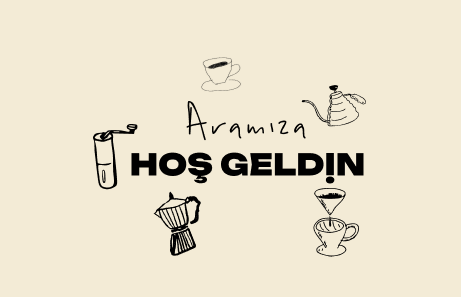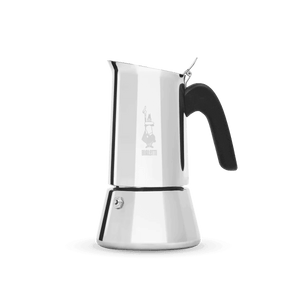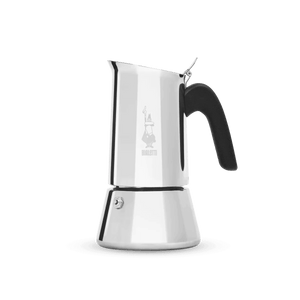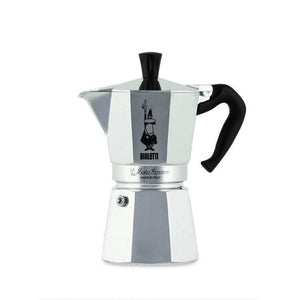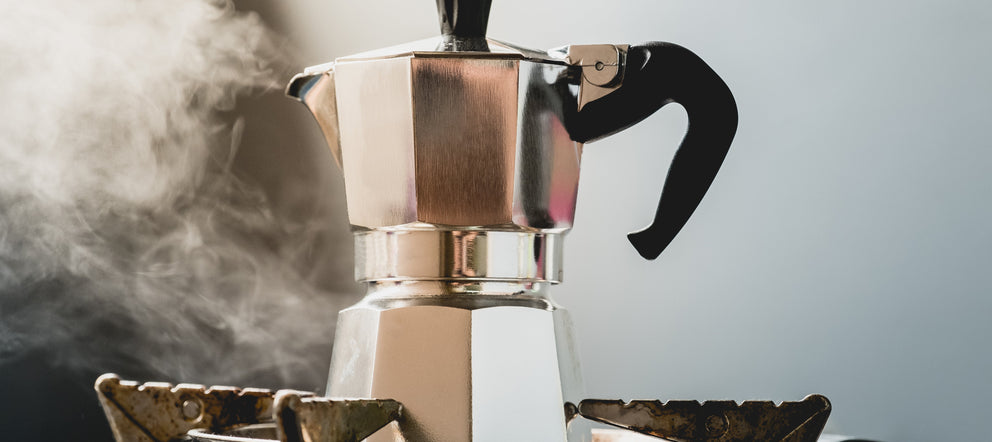Basically a Moka Pot is equipment that uses pressure to make coffee, similar to how a pressure cooker works.
Usually Moka Pot equipment is made from aluminum due to aluminum's ability to easily distribute heat evenly and is much more cost effective.
For example, almost all of the best-selling moka pots are made of aluminum, and they all cost quite a bit.
These days, however, it is quite easy to find many different aluminum Moka Pots that we mentioned above. But many home baristas have started to prefer the more expensive stainless steel Moka Pot, which is now known to be more durable, safe and tastier.
But are these stainless steel versions really worth their hefty price tag?
If we look at the best selling moka pot, we see that it is made of aluminum. But we should not forget the fact that aluminum equipment changes the taste of coffee. On the other hand, its maintenance is much easier than others and its sealing is extremely simple.
So what is the difference between Aluminum and Stainless Steel Moka Pot?
For starters, it's worth remembering, both are made for espresso. There are three separate sections of equipment. The filtration and the safety valve are exactly the same.
The first chamber is located at the bottom and is filled with water. The pressure created in this chamber allows the water to rise and flow through the second chamber.
The second chamber is shaped like a funnel into which the ground coffee is placed. The reason why it is in the shape of a funnel is that when the water is boiled, it rises from the funnel and reaches the ground coffee in the middle chamber and infuses it. Of course, this middle chamber has small holes to prevent ground coffee from falling into the first chamber and to allow water to pass through the second chamber.
The third chamber is where the brewed coffee is collected. The shape of the third and upper chamber is an inverted funnel with a long funnel in the center through which the brewed coffee flows.
As a result, the brewed coffee is much hotter than when brewed in a standard container due to the superheated water from the use of pressure.
Because stainless steel does not conduct heat as efficiently as aluminum, we are much more likely to get an uneven extraction in a stainless steel moka pot. Also, gaskets on steel moka pots may need to be replaced more often.
Even with premium stainless moka pots, the steel base must be perfectly placed over the burner to help distribute the heat evenly around the pot. If one side gets hotter than the other, it will negatively affect your brewing. If you leave the moka pot on the burner for a long time, only one side of the seal will burn.
So what is the difference between the two?
As you know, stainless steel is a durable metal. Aluminum, on the other hand, is a piece of equipment that wears out a little more easily.
Stainless steel will not conduct heat as efficiently as we mentioned before, but it is much safer to use in terms of health.
Aluminum equipment is much lighter and cheaper than steel. For this reason, it is easy to carry and buy because it is inexpensive. Although they are made of aluminum, they are still quite durable.
As aluminum dissipates heat better, it is much easier to brew coffee in an aluminum equipment. However, the cleaning process is just as simple.
Another advantage of aluminum equipment is that when it's time to replace a part, you can do it easily because parts are easy to find.
Coffee flavor of stainless steel moka pot
Another thing that many people don't like about aluminum is that, at high temperatures, aluminum gives some metallic flavor to the coffee produced. These levels of aluminum leaching out of the moka pot are safe for human consumption but adversely affect flavor. Stainless steel, on the other hand, does not.
It is a common practice to prevent flavor deterioration. Never wash your aluminum moka pot completely with abrasive and soap. Instead, we recommend rinsing your moka pot immediately with hot water and non-abrasive cloths.
It is no coincidence that the Bialetti brand is seen on its products as if they were worn. The metal is sealed and this makes the coffee taste better.
So why not use steel over aluminum?
You don't want to do this because steel causes hot spots due to uneven heat distribution. Aluminum models work better gradually. At the same time, one should not forget the idea that they should be washed with soap after each use.
Are stainless moka pots safer than aluminum?
All moka pot equipment are equipped with gaskets that ensure a safe pressure in the lower chamber. Because the moka pots are divided into three, the gaskets hold the chambers together. It also prevents pressure from escaping its separations.
Moka pot is equipped with all these safety valves. These valves are another way steam escapes. Of course, steam can only escape through the safety valves in case of heavy buildup, or in other words, when too much steam has accumulated in the lower chamber. For example, Moka Express has its own patented valve, making it the safest moka pot on the market.
On the other hand, a clean filter in the second chamber prevents unnecessary steam generation as it is the main route through which the steam will pass. This also ensures that the coffee is well brewed.
Also, some recipes specify how much water to use per amount of coffee beans. This ratio is very important as it plays a major role in the emergence of the flavor of the coffee. Knowing how much water is used also serves another purpose.
Aluminum and Stainless Steel
Moka pots have traditionally been made of aluminum due to its malleability, making it much easier to craft complex shapes and features compared to using thicker metals such as steel.
Moka pots offer practically the same features and functionality, but do both ingredients really add flavor and safety to users?
We can solve these questions by comparing the following four criteria.
Corrosion
Stainless steel has an element called chromium that provides corrosion resistance. At the same time, stainless steel is non-porous, meaning that there is not even the smallest hole in its surface. These features only increase the corrosion resistance feature. Aluminum, on the other hand, is prone to corrosion, especially since it is subject to oxidation caused by acidity. Well, since we're talking about coffee here, yes, coffee is acidic and therefore corrodes aluminum much faster.
Winner: Stainless steel
Heat transfer
Aluminum has a better conductor of heat due to its more basic composition. It has fewer layers than stainless steel. As a result, the coffee brewing process takes place faster in aluminum.
Winner: Aluminum
Resistance
Stainless steel is much stronger than aluminum, based on the fact that it is less malleable compared to the other metal. This is one of the biggest reasons why Moka pots started to be made from aluminum. Stainless steel is also much stronger than aluminum. As a result, stainless steel is more durable because both metals are subjected to the same amount of pressure.
Winner: Stainless steel
Ease
There is no doubt that all eyes are on stainless steel here. The chrome feature makes it very, very easy to wash and wipe the coffee residues in the chambers. A little extra wiping may be required for aluminum moka pots.
Winner: Stainless steel
Cost
We have already mentioned that aluminum is much cheaper than stainless steel moka pots.
Winner: Aluminum
Conclusion
If we look at the things we mentioned above, if your budget is available, the stainless steel moka pot seems much more logical. Also, due to the durability of stainless steel, it is much more likely to withstand the intense pressure created by the lower chamber.
From a flavor standpoint, both mokas do well in the pot. But as we mentioned above, the flavor produced by moka pots really depends on the factors mentioned above. Therefore, let's not discuss the taste of aluminum and stainless steel moka pots.
If you're looking for a more traditional mocha brewing style, opt for aluminum as traditional moka pots are made from aluminum.
